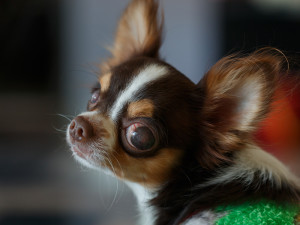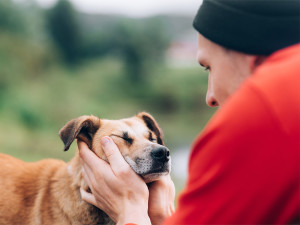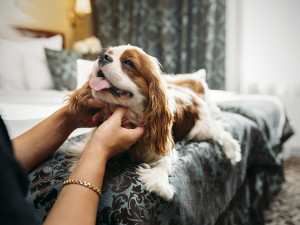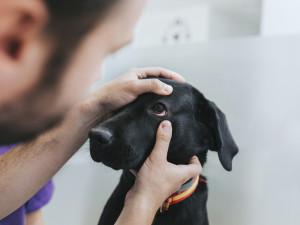What to Do if Your Dog’s Eye Is Swollen
What you don’t do is ignore it. Here’s what it can mean and how to help your dog heal.
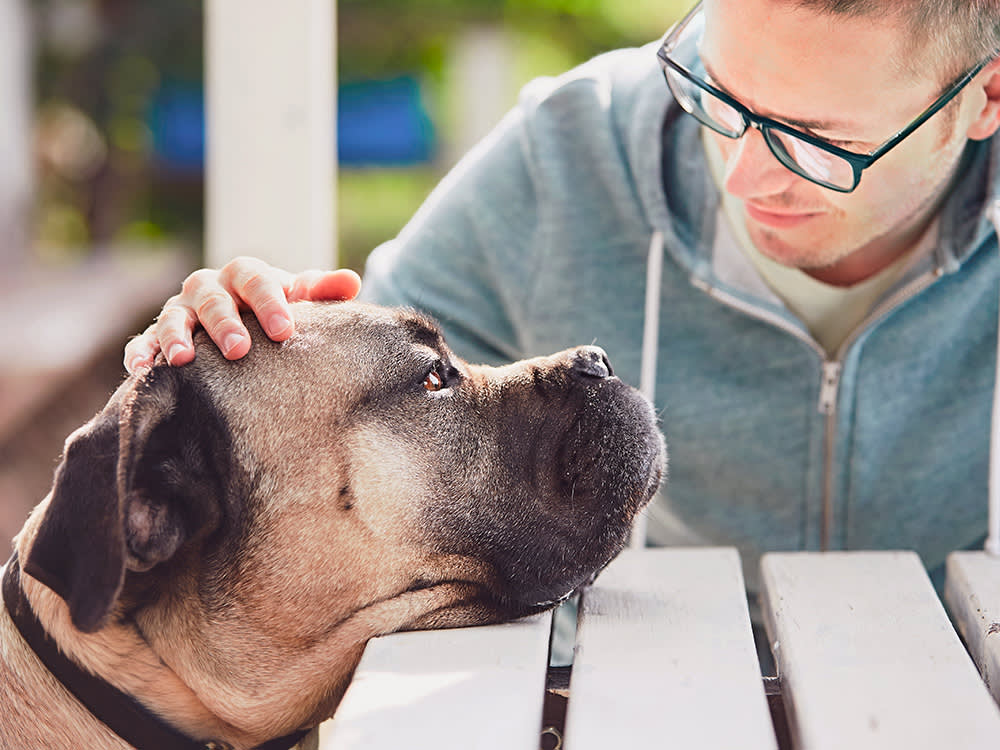
Share Article
In This Article:
Overview of Dog Eye Health Common Causes of Swollen Eyes How A Swollen Eye Is Diagnosed Treatment Options How to Prevent Swollen Eyes When to Visit a Veterinarian
Our dog’s eyes provide a lot of insight. They’re capable of making different expressions to show us how a dog feels. Of course, they’re also pretty good at begging. So, if you come home to your dog’s eye being swollen, this can be a bit alarming, to say the least.
There are many reasons a dog’s eye could become swollen, some more severe than others. We’ll walk you through some of the causes and give you tips on what to do next, to help your pup’s eye return to normal.
Overview of dog eye health
When a pup’s eyes are working as they should, you probably don’t even give them a second thought. But when something is wrong with their eyes, this will be written all over your dog’s face. Healthy eyes should be clear with no discharge. While some tears are normal, they shouldn’t be spilling out, unless something is wrong.

The tissue around the eye, also known as the conjunctiva, typically isn’t visible. You’ll just see the eyeball itself peeking out between your dog’s eyelids. Anytime you can see red or puffy tissue at the borders of your dog’s eyeball, it means something is causing swelling.
Dogs have three eyelids. What? Yep, they have the normal top and bottom ones that you do and then there’s a third one that hides out at the inner corner of the eye. Again, you won’t normally see the third eyelid unless your pup is having issues, so if it’s sticking out, you’ll want to give your pup a closer look.
Also, dogs tend to leave their eyes alone unless something is bugging them. If a dog’s eye is painful, they may squint, paw at it, rub it, or not want to open it at all.
Common causes of swollen eyes in dogs
A dog’s eyes may be tough, but they’re also a little bit sensitive. So, anything that could irritate other parts of the body will do so in the eyes. This includes the following causes.
Allergies
If you have seasonal allergies, you know all too well what they can do to an eye. Dogs can be allergic to things like pollen, mold, and dust mites — all of which can lead to swelling and redness of the conjunctivaopens in new tab. You may also see lots of eye-watering, and maybe sneezing and a runny nose as well (though that is less common in pups).
Dog eyes can also be very sensitive to things we use each day, such as cleaners and yard chemicals. If your dog’s eyes get swollen and red every time you disinfect the floor, your cleaner could be to blame.
Infections
The eye has all kinds of mechanisms in place to keep things that don’t belong in the eye out of the eye. Tear production is one pretty decent mechanism that helps wash out bacteria, viruses, and other microbes, but it isn’t always 100 percent effective. Dogs can still get infections in their eyes or the conjunctiva, both of which can cause a lot of discomfort, swelling, and discharge.
Injuries
Eyes also have a good number of protective mechanisms in place to prevent injuries. They have cat-like (or should we say dog-like?) reflexes that cause the eyelids to blink in a split second when the eye is in danger of getting poked. And they have tear production to help flush itty, bitty, scratchy things out of the eye before they do any damage. Nevertheless, dog eyes can get injured. Bumping into the wall or a sharp object can cause swelling around the eye. Also, things in the eye that cause corneal scratches or ulcers can lead to swelling as well.
Let’s look at some brachycephalic breeds. These are smushed-faced dogs, such as Pugs, Boxers, and French Bulldogs. While cute, their facial anatomy actually makes their eyeballs stick out more. This puts them at greater risk for eye injuries, so if you have a pup with bulgy eyes, watch them closely for any eye swelling, discharge, or discoloration.
Foreign bodies
Dogs stand close to the ground. Couple that with a desire to stick their nose into anything and everything, and you have a pretty good recipe for eye issues. Things such as grass seeds, stickers, or even dirt can do a lot of damage when they touch a dog’s eye. You may see swelling, redness, discharge, and discoloration as a result.
Glaucoma
Glaucoma is an issueopens in new tab where the pressure inside the eye increases, causing painful swelling and enlargement of the globe. It can be due to an anatomic abnormality within that eye that prevents ocular fluid from draining properly, or it can be brought on by many issues including an infection, cancer, or cataracts. Either way, glaucoma needs to be treated by a veterinarian as soon as possible, or it may cause blindness.
How a swollen eye is diagnosed in dogs
Eyes aren’t something you want to mess around with at home. Instead, see your veterinarian (or an ER vet) immediately if you notice any swelling to get a proper diagnosis of the cause. Your vet will start by looking your dog over. They’ll examine the eye, including under the eyelids and inside the eyeball. This may take some sedation and local anesthetic, especially if your pup’s eye is sore.
For injuries or foreign bodies, your vet may also stain the eye to check for scratches in the cornea and ensure your dog is producing tears as they should. Internal pressures will be checked using a tonometer for swelling of the eyeball.
Treatment options for swollen eyes in dogs
In most cases, eye issues require a veterinarian visit for a diagnosis and treatment plan. However, in milder cases, there are a few things you can first try at home.
Home treatments
If your dog’s eye is mildly irritated, or something like allergies that have caused a mild problem before, there are a few things you can do. In this case, try flushing out your dog’s eye with saline solution and gently wipe the outside of it with a warm, wet washcloth. Applying a cold compress may help as well if your pup can sit still. If things aren’t looking better — or if they take a turn for the worse — see your vet. Do not wait to see your vet if you are at all concerned that the issue is not clearing up.
Veterinary treatments
If you’ve never seen your dog have swollen eyes before, or if this is something more than just mild inflammation, see your vet. Treatment may include medicated eye drops to help with allergies or infections, removal of foreign objects with sedation and anesthetic, or medications to help control glaucoma.
Corneal ulcers from injuries or foreign objects may do well with medicated eyedrops. Or they may require a little dark confinement where your veterinarian sews your dog’s eyelids together to protect the eye and help with healing.
How to prevent swollen eyes in dogs
You want your dog to live their life to the fullest: So before you go covering them in bubble wrap, just know that not every eye issue can be prevented. You can do a decent job by keeping a close eye on your pup when they’re out and about, to protect them from foreign objects and injury. Also, see your veterinarian regularly, so they can catch things before they become big issues. And monitor your dog at home for any minor abnormalities (such as some extra tearing) before they become full-blown issues.
When you should visit a veterinarian
You don’t want something to mess up your dog’s vision, so don’t hesitate to see your veterinarian any time your dog has a swollen eye. If the swelling is minor and your pup isn’t uncomfortable, you may monitor it for a day or two to see how it does. But if swelling is severe, and there is a lot of squinting, pawing at the eye, discharge, redness, or discoloration to the eyeball — see your vet.
Bottom line
A swollen eye in dogs can be caused by factors such as injuries, infections, foreign objects, or glaucoma.
To keep your dog’s eyes as healthy as possible, things like swelling, discharge, and redness should be addressed by a vet.
References
“Glaucoma.” Cornell Richard P. Riney Canine Health Center. https://www.vet.cornell.edu/departments-centers-and-institutes/riney-canine-health-center/canine-health-information/glaucomaopens in new tab.
Johnson, Tony DVM. “Allergic Conjunctivitis in Dogs and Cats.” Veterinary Partner. 13 Oct 2021. https://veterinarypartner.vin.com/default.aspx?pid=19239&catId=254086&id=10517463opens in new tab.

Dr. Chyrle Bonk, DVM
Dr. Chyrle Bonk has been a mixed-animal veterinarian since 2010, with a special interest in rehabilitation. When she's not practicing or writing about veterinary medicine, you may find her exploring the outdoors with her family or tending to her cows, horses, chickens, or cats and dogs.
Related articles
![Cavalier King Charles Spaniel's eye is examined on the bed by a person]()
Dogs Get Dry Eye Too...Some Breeds More Than Others
Eyes without tears are only for Cameron Diaz in The Holiday.
Why Does My Dog Have Eye Boogers?
Next question: Will they let you anywhere near their eyes to wipe off that gunk?
Are Dogs Color Blind? How Do We Know What Colors Dogs Can See?
It’s not all black and white.
Cherry Eye in Dogs: Why Is Your Dog’s Eye So Red?
That would be a cherry eye, and you’ll want to see your vet.
Cloudy Eyes in Dogs: Causes, Risks, and How to Manage Vision Changes
There are a few possible reasons for your pup’s murky stare.
